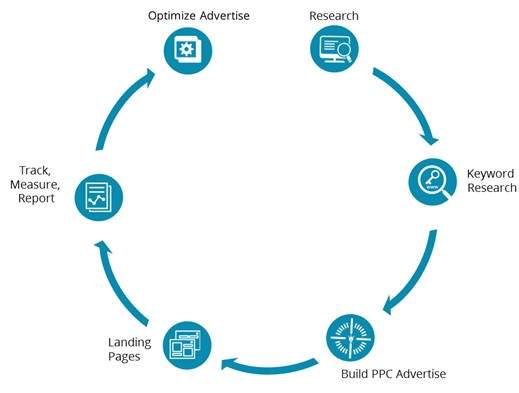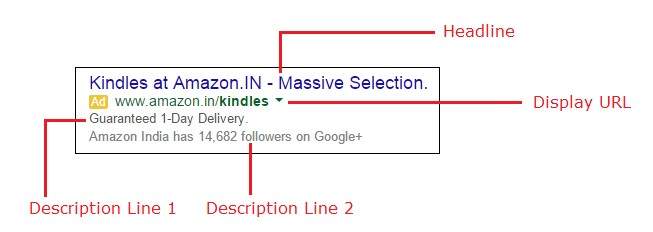In today’s world of internet marketing, the advertisers are in a fierce race of grabbing the space on webpages to put up their ads. When thousands of advertisers compete, only those who create the most effective and catchy ads stand out from others and help accelerate the seller’s business.
Creating a PPC Ad
Refer the diagram shown below. To create an effective and compelling ad, the following methodology is helpful:

Market and Audience Research
Research the market. Answer questions such as:
- How many people are using product or service that the seller is selling?
- How many people use various parallel products?
- What is the budget for the ad?
- What does the user want?
- What is user’s motivation?
- Why does the user need this product or service?
- What words are going to resonate with each group of keywords?
Keyword Research
Find out the following:
- Which are the products searched by the users in the seller’s business domain?
- Who are looking for the products similar to those offered by the seller?
- What is the cost to bid for PPC ad on relevant searches (keywords)?
- What keywords the competing advertisers are using?
Build Pay-Per-Click Ad
Build the PPC ad. Put groups of related keywords into one ad group. Create multiple ads and split-test them for each ad group.
Build Landing Pages
Build the respective landing pages combining aesthetics, art, and technology.
Track, Measure, and Report
Monitor and measure the following:
- Impressions (how often your ads appear),
- Click-through rate (how often your ads are clicked on),
- Response rates (how often people respond to what website offers) for various keywords, ad groups, and ads.
Optimize the Ad
Optimize the ad as follows:
- Using the monitoring data, refine and improve the keywords, ads, and landing pages as and when required.
- Make sure all the changes are implemented and performance is trending in the right direction.
- Remove non-working words, images, links, and move on.
Elements of a PPC Ad
Refer the following image to understand the elements of a PPC ad.

- Headline - This is the main title of the ad. It must be magnetic, crisp, and compact.
- Display URL - This is the link of the relevant web page where the prospects will be taken onto. It is not required to be the exact landing page but it should be relevant. You can, for example, include your website with the top keyword in your Ad Campaign.
- Description Line 1 and 2 - This is the body of the ad. It describes the product or the service the seller is offering.
Creating a PPC Ad Using Google AdWords
A well-written, persuasive, and concise copy can make a difference between success and failure in a PPC advertising campaign.
Step 1: Know the Rules of Framing an Ad
If you use Google’s AdWords, this is how you should frame the PPC ad:
- Headline: Catchy, Correct, Informative, Crisp, 25 characters long.
- Description: Two lines description of product or service, 35 characters long.
- Display URL: 35 characters long. If you run out of description size of 35 characters, do not continue the description text into the Display URL. For example, do not frame the second description line such as "Visit this site:" or "Learn more at...".
- Do not use the Display URL field as another line of ad text.
- Do not make the ad text appear cut off abruptly or incomplete.
- The Display URL is required to be on the same domain as the real URL.
- Pay due attention to the grammar.
Step 2: Identify True Competitors of Seller
Identify who is competing with you in bidding for your target terms and who is consistently getting the top ad rank. Based on this insight, you can find out the companies and their ads. You also need to consider the advertisers who are completely irrelevant to your business; treat them as competitors, as they are also going for the same share of your prospect attention.
Step 3: Identify Seller’s Assets, USPs, and Your Credentials
Go through the product or service offering of the seller and identify his online assets. What can you offer to the prospective user?
- Testimonials - What are the user reviews of this product or service?
- USP of the seller - Unique selling proposition (USP) is a factor that differentiates a product or service from a competing product. The USP includes:
- Cost of the product, value for money
- First of its kind product in market, innovative
- Quality of the product
- Additional offers along with the products
- Seller’s Credentials - Has the seller won any awards? Is the seller proven to be the best in his domain industry?
- Show Off to Your Prospective Customers - Have you work with any well-known brands? Then this is a good time to show off your credentials. This way you stand out from your advertising competitors.
Step 4: Create an Effective Call-To-Action (CTA)
Ad Copy is your only opportunity to convey your audience exactly what action you want them to take, once they reach the website. For example:
- Direct Response Phrases - Call, Register, Purchase, Checkout, Download, and Donate.
- Lead Generation Phrases - Contact us, Request a Quote, Start, Verify, Access, Receive, Fill, and Enroll.
- Engagement Phrases - Watch, See, View, Read, Discover, Uncover, Check Out, Visit.
Step 5: Write Your Copy of Ad
As an advertiser, you write for your audience, not for yourself. Think of the intentions your user is searching with. Think how accurately your ad copy can answer their questions or help them.
- Use numbers and exclamation marks. They capture user’s attention.
- Use abbreviations if they are well known and non-ambiguous. They save space.
- It helps increase Click-Through-Rate (CTR) if you capitalize each word besides the articles in your copy.
- Use your keywords in the headline. Google makes them bold, which automatically makes the ad prominent.
Step 6: Add Extensions
Another way to increase your click-through rate is to add extensions to your ads. Add contact numbers, location information, well-organized site links, reviews and testimonials about the product or services for the positive aspects given below:
- Contact numbers and location extensions boost conversation.
- Site links help users to get what they are looking for on the website with just one click. Site links appear in ads at the top and bottom of Google search results.
- Reviews and testimonials build up confidence about the product or service.
Step 7: Repeat Keywords on the Landing Page
The keywords used in your ad should be repeated on the landing page. It helps the prospect feel reassured of visiting the right place for his requirements.
Step 8: Test
Use AdWords Experiments (beta) to test different versions of your ad. If required, refine them based on the judgment of what works best for your ad and what converts.
Related Searches:
0 comments:
Post a Comment